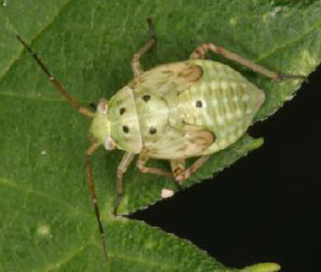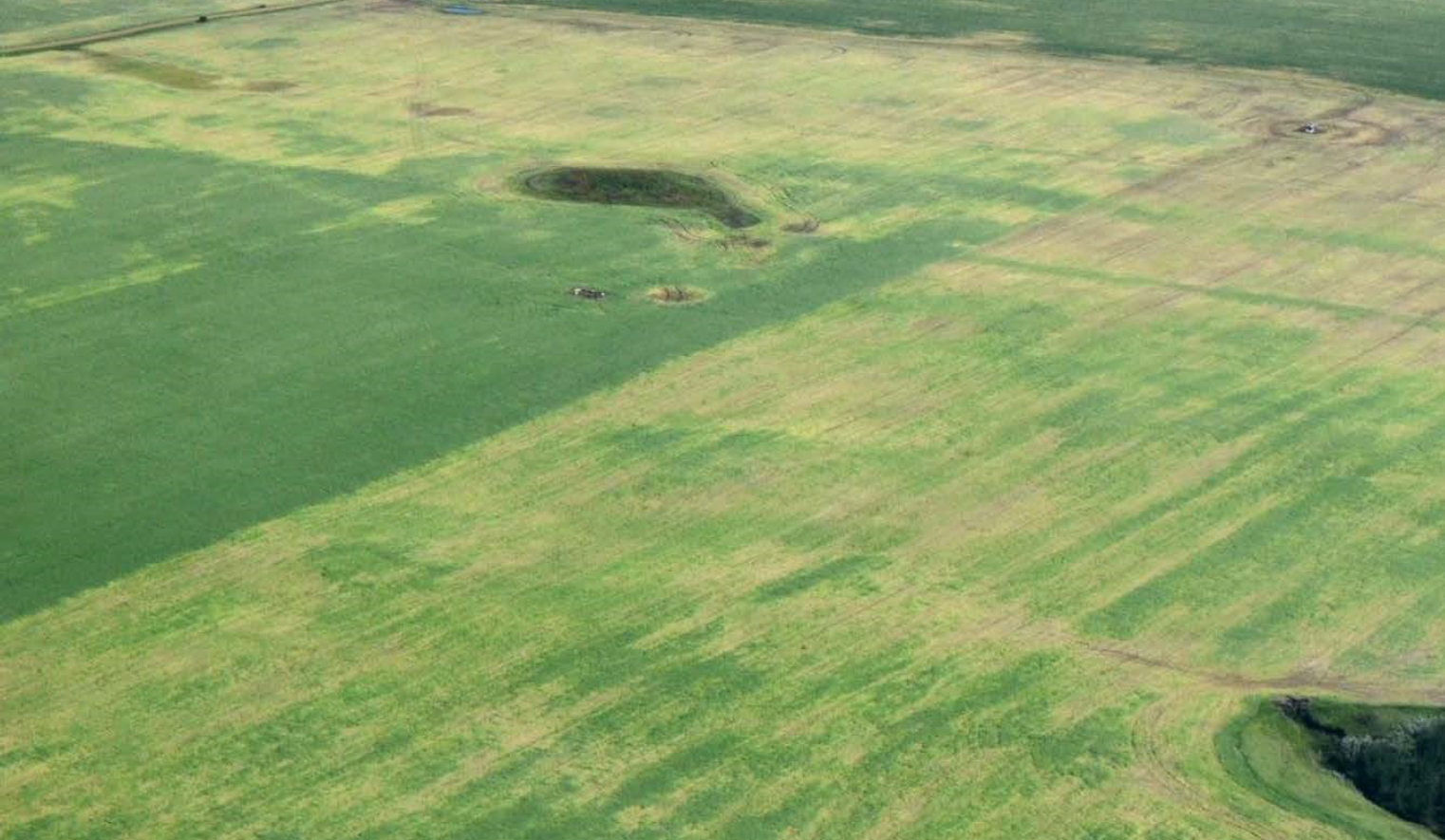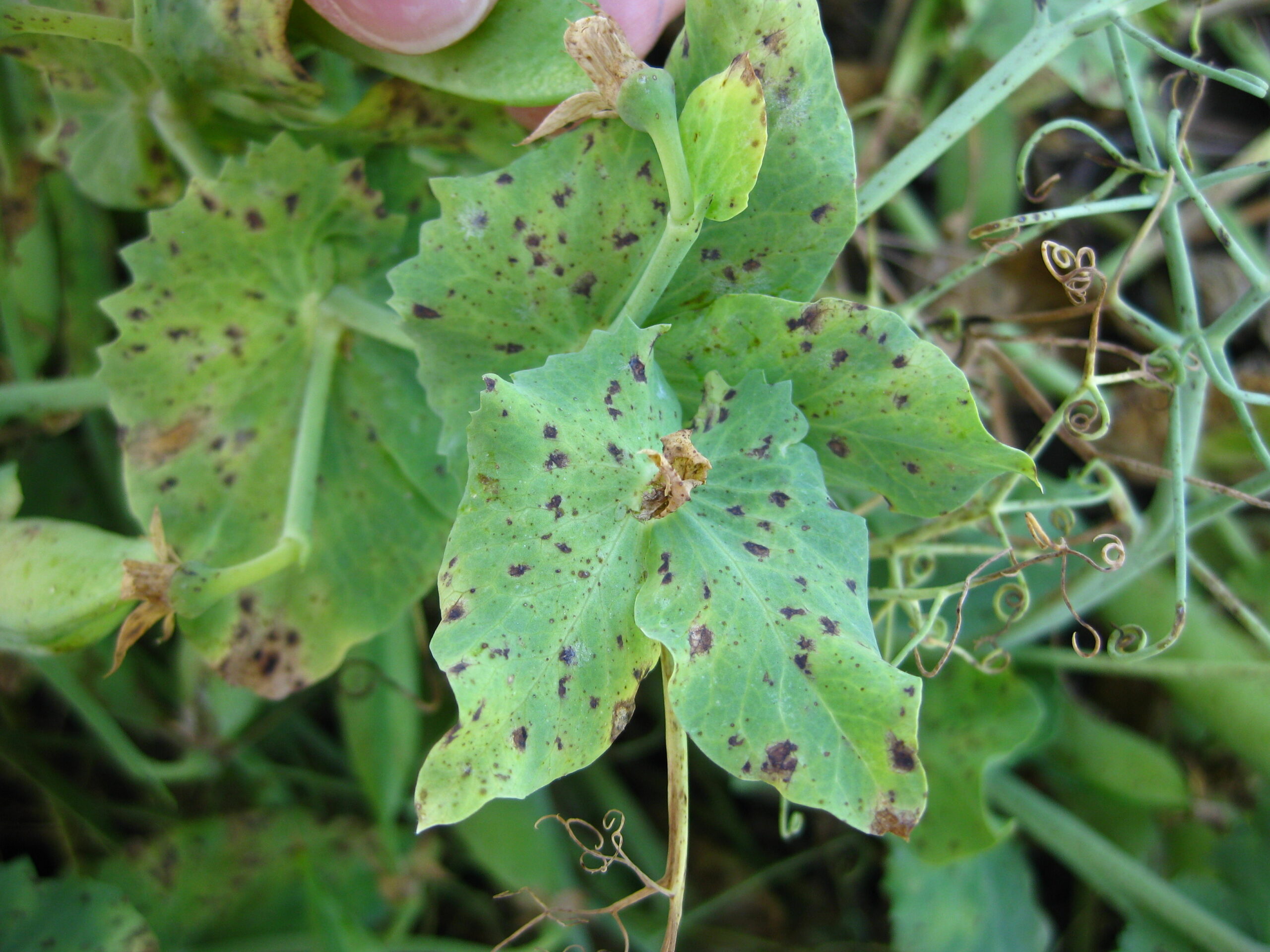Jennifer Bogdan, PAg, CCA
Lygus bugs are well known to be an important pest of seed alfalfa and, intermittently, of canola in Saskatchewan. They can also have an economic impact in certain pulse crops, particularly in faba beans, by downgrading the quality of seed grown for the human consumption market.
Host Crops and Crop Injury
Lygus bugs feed on numerous species of crops, native plants, and weeds. For example, the tarnished plant bug (Lygus lineolaris) has over 385 recorded hosts from 55 different plant families, including both broad- leaves and grasses. This lygus species also has a very broad distribution range that spans Central America to Alaska. Because of their wide host plant range, lygus bugs potentially can be found in all pulse crops. However, economic losses in quality due to seed damage are primarily a concern for faba beans, and to a lesser extent a concern for peas, lentils, and dry beans. While flower-blasting can occur from lygus feeding, yield losses are generally not a concern in pulse crops, as their indeterminate growth habit allows the plants to compensate for aborted flowers. How- ever, potential delays in maturity may indirectly affect seed quality from frost damage.
Lygus bug adults and nymphs pierce plant tissue and suck plant sap with their needle-like mouthparts, while also injecting digestive enzymes that are then sucked back out along with pre-digested plant nutrients. They preferentially feed on the nitrogen-rich growing points and reproductive parts of the plant, such as buds and flowers. Lygus bugs will also pierce through pods to feed on the developing seeds, causing visible damage to the affected seeds due to the enzymes in the saliva that are left hehind in the plant.
In faba beans, lygus-damaged seeds develop dark coloured perforations (Figures 1 and 2). Since the market for human consumption has a very low tolerance for seed damage, faba bean samples that have greater than one per cent perforated damage are downgraded to Number 2 Canada.

Source: Michael Dolinski

Source: Michael Dolinski
Recent research in Alberta studied the relationship between lygus bug and chocolate spot (Botrytis spp.) and found that lygus bug pressure did not increase the amount of chocolate spot observed on the seed, meaning seed damage from these two pests occurs independently of each other. Also, Botrytis did not cause seed perforations, only discolour- ation of the pod and seeds.
In peas and lentils, lygus damage can cause chalk spot, which is pitting of the seed coat that sometimes has a chalky, white appearance and can lead to downgrading (Figures 3 and 4). In Saskatchewan, lygus bug infestations and seed damage in lentils has been reported periodically, but no issues of lygus bugs in peas have been reported. However, chalk spot was a concern in peas in North Dakota in 1996 and 2002, although the damage could not fully be attributed to lygus bug feeding, as another probable cause was bruising on the seed from harvesting at too high of seed moisture content.

Source: Janet Knodel, North Dakota State University

Source: Janet Knodel, North Dakota State University
In different types of beans and soybeans, necrotic seed pitting and pod abortion due to lygus bug feeding has been reported in earlier research. Research from 2008 to 2010 in Manitoba showed that lygus bugs successfully developed in commercial fields of soybeans and dry beans (navy and pinto), although soybeans were deemed only a marginal host for the production of the second generation of lygus bugs. Since fewer nymphs survived on soybeans compared to dry beans, soybeans are not a preferred host for lygus bugs. In comparison to canola fields, lygus numbers were lower in both dry beans and soybeans. This research also found that there were no yield or seed quality losses due to lygus bug feeding in any of the crops, although economic damage could occur in years of extremely high lygus bug pressure.
As lygus bugs readily infest canola and alfalfa, areas with high acreages and tight rotations of these crops are at increased risk for damage in pulse crops from lygus bug feeding. Some pulse crops with later maturity (faba beans, lentils, dry beans, soybeans) can stay greener compared to neighbouring mature crops, resulting in movement of lygus bugs into the pulse fields once their other host crops are cut in-season (alfalfa) or swathed (canola).
Identification and Life Cycle

Source: Héctor Cárcamo, Agriculture and Agri-Food Canada
Lygus bugs are native to the Prairie provinces and occur as a complex of several different species, namely Lygus lineolaris (tarnished plant bug), L. borealis, L. keltoni, and L. elisus (pale legume bug) (Figure 5).
The 2016 Insect survey in faba bean fields across Saskatchewan identified Lygus lineolaris as the prominent species, followed by L. borealis as a distant second. Lygus borealis, however, is a dominant species in alfalfa. In canola, Lygus keltoni has replaced L. elisus as the dominant species in the drier, southern regions of the Prairies, whereas L. lineolaris is dominant in the more humid central and northern regions.
Adult lygus bugs are five to six millimetres long, vary in colour from pale green to reddish brown to black, and can be mottled or uniformly patterned. Like other plant bugs, lygus bugs have a distinct triangle or V on their backs, between the upper part of their wings (Figure 6). Young lygus nymphs are light green, wingless, and can be mistaken for aphids. However, lygus nymphs run quickly (aphids move slowly) and do not have cornicles protruding from their abdomens like aphids do. As the nymphs progress through their five instars (growth stages), they develop five black spots on their backs, as well as wing pads (Figure 7). Nymphs at this stage should be included in sweep net counts when assessing lygus bug populations.
Adult lygus bugs overwinter under debris, plant litter, and perennial plant cover in field margins, ditches, fence lines, or treed areas. Adults become active in the spring, feed on early- growing plants, then mate and fly to host crops and plants to lay eggs. The female inserts her eggs into the stems, leaf midribs, or petioles of the host plants, and the first nymphs appear within seven to 14 days. It takes approximately 45 days to develop from egg to adult.
Two generations of lygus bugs can be produced in southern Saskatchewan, whereas only one generation is produced in the north. The Saskatoon area has about 1.5 generations of lygus bugs produced. In northern areas, egg-laying (which is temperature dependent) begins around mid- to-late May, with nymphs appearing from late May through July, and adult populations peaking in late August and September. In the south, egg-laying can begin in early to mid-May, with nymphs emerging from mid-May to mid-June, and adult populations peaking in mid-July. The new adults then move into nearby flowering crops, where feeding and egg-laying again take place, and second generation nymphs emerge in late July to early August, and adults peak in early September. These second generation nymphs will feed on host crops throughout August, and feeding damage can potentially become economical. In alfalfa, nymphs can be mature at the time of the first cut for forage, which can force a large migration of new adults into crops such as pulses or canola that are flowering at this time. Hot, dry weather will promote lygus development and crop damage from feeding can be worse under these conditions. Adults will remain in their host crop until late summer and if that host crop is canola and the crop is swathed or maturing, the adults will move into later maturing hosts, such as faba beans or alfalfa, and continue to feed until hibernation.

Source: Michael Dolinski

Source: Michael Dolinski
Scouting and Economic Threshold
Monitor pulse crops for lygus bugs during flowering to pod development, until seeds in the pod become firm. Make 10 to 25, 180° sweeps at five to 10 representative locations in the field during the warm, sunny part of the day when lygus are most active (temperatures greater than 15°C). More sweeping provides more accurate lygus estimates, but at the very least, sample a minimum of two field edges and at each location, walk an arch that includes four to five sweep locations approximately 25 metres apart. Usually 10 sweeps are made at each location but for faba beans, 25 sweeps are recommended due to the low number of lygus required to do damage in the crop. Count both adults and later instar nymphs. If the nymphs have the five black dots on their backs, include them in the count. Small nymphs that do not have wing pads are not expected to damage the crop and are not counted when estimating thresholds, providing the crop is monitored at the correct stage (ex. early pod stage for faba beans). If crop growth is too heavy, samples can be taken near the field edges or at right angles from the edges, as long as the crop is at a similar stage as the main part of the field. Samples should not be taken from poor areas with thin stands because lygus are far more abundant in these areas compared to thick stands, and field populations will be overestimated.
The economic threshold for peas and lentils (based out of the Pacific Northwest) is 10 or more lygus per 25 sweeps. If seven to 10 lygus per 25 sweeps are found, continue monitoring. If less than seven lygus per 25 sweeps are found, no treatment is necessary. A single insecticide application at late flowering to early pod should be sufficient for control. There is no economic threshold established for faba beans, but researchers in Alberta are currently working to develop one. Preliminary information suggests a low threshold, as few as five to 10 lygus per 10 sweeps, at the early pod stage in faba beans.
Management and Control
Chemical Control
Limited insecticide research has been conducted for lygus bugs in pulse crops. A three-year study in faba beans from 2001 to 2003 at two sites in northern Alberta (six site years in total) was set up to determine the effect of multiple applications of insecticide (Matador®) on lygus bug feeding damage. Matador®(lambda-cyhalothrin) was applied in four treatments (July 2, July 2 and 15, July 2, 15, and 30, and July 2, 15, 30, and August 13), and compared to an untreated control. While the insecticide treatments did decrease the number of lygus perforations on the seed compared to the control by 40 to 60 per cent, even four applications were not enough to prevent the seed from being downgraded. In some cases, Matador® appeared to contribute to yield increases due to larger seed size, but this yield increase was variable, ranging from zero to seven bushels per acre. The study also concluded that the damage in faba beans occurs during pod development, not during initial flower development.
If insecticides are required in pulse crops, avoid spraying a flowering crop during the day when pollinator activity is high. Make the application in either early morning or late evening. Faba beans rely heavily on insects for pollination (ex. yield production), so great consideration is needed when deciding to spray an insecticide.
Cultural Control
Early seeding of pulse crops, especially faba beans, is recommended to get the crop to a more advanced stage in order to avoid the peak population of new generation lygus adults that can migrate in from other crops such as swathed canola in late summer. Good weed management may help discourage lygus bugs from being attracted to flowering weeds in pulse fields. This includes an effective pre-seed burnoff to control winter annuals, as well as management of perennial broadleaf weeds, such as Canada thistle, during the years prior to planting a pulse crop.
Biological Control

Source: Scott Bauer, USDA Agricultural Research Service, Bugwood.org
At least three native species of parasitic wasps from the Braconidae family (Peristenus dayi, P. mellipes, and P. howardi) will lay their eggs inside early-instar lygus bug nymphs, and the Peristenus larva kills its lygus host when the larva emerges to pupate (Figure 8). Predatory bugs, such as damsel bugs and big-eyed bugs, as well as spiders can also prey on young lygus nymphs. Hard rains can also be detrimental to early instar nymphs. One study in alfalfa found there was a 50 per cent reduction in new generation Lygus lineolaris nymphs after a heavy rainfall. It is likely that the nymphs in prairie crops suffer the same fate.
Summary
- Faba beans are especially vulnerable to lygus bug feeding damage, and subsequent seed downgrading, during the early pod stage.
- Lygus bugs can move from freshly cut alfalfa fields into flowering crops, as well as from senescing crops into still-green pulse crops, such as faba beans.
- Faba beans require insect pollination for maximum yield production. Insecticide applications should only occur when absolutely necessary, and during the early morning or late evening, to minimize the loss of beneficial pollinators.
- Early seeding of pulses is recommended so the crop is more advanced in maturity to help avoid the flush of new generation adults that can move in from other crops or weedy areas.


